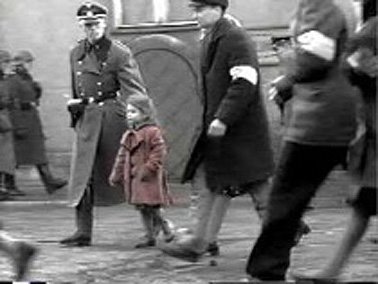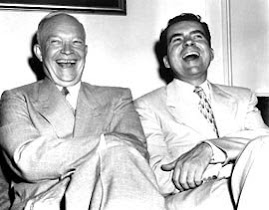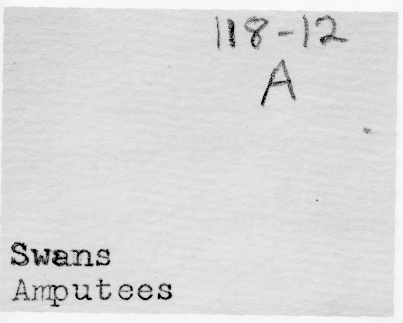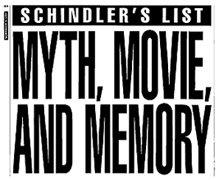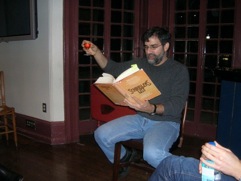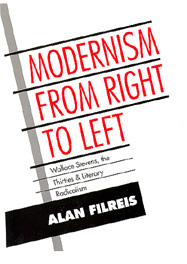 Below is an excerpt from a review Michael Coyle (author of Ezra Pound, Popular Genres, and the Discourse of Culture) wrote several years ago about my book Modernism from Right to Left. The full text of the review is here.
Below is an excerpt from a review Michael Coyle (author of Ezra Pound, Popular Genres, and the Discourse of Culture) wrote several years ago about my book Modernism from Right to Left. The full text of the review is here.[Filreis] has secured an eminent place not only among the arbiters of Stevens's reputation, but also among historians of 20th century American culture.
Modernism from Right to Left will probably turn away casual browsers, but it authoritatively documents Stevens's full and particular involvement with the political troubles of Depression - Era America. Filreis proceeds by taking on much of what we have always "known" to be true, and one of his chief staging grounds is a long poem Stevens published in 1936 called "Owl's Clover." "Owl's Clover," which is not even included in Stevens's Collected Poems, has long been thought either an anomaly in the poet's work or an aesthetic, reactionary rejection of the leftist politics that for many marked the '30s as the "red decade." In fact, "Owl's Clover" is, as Filreis documents, neither a rejection nor a straightforward acceptance of the left. As the title of his book indicates, Filreis charts a gradual shift in the poet's orientation. Stevens never became a "leftist" poet, but his poetry performs a conscientious self - examination that in its own terms perceptibly turns poetic response to responsibility.
To follow the process by which Filreis develops the evidence for this kind of historical revisionism is to understand something important about literary study in our time. For a literary scholar, the ultimate evidence is always textual. But, because Filreis asks different kinds of questions than did his own teachers at Colgate, he contextualizes textual evidence, and regards individual poems not in isolation but in their contemporaneous relations to other poems, and other kinds of writing.
The research that informs Modernism from Right to Left is both impressive and impressively marshaled. The author ranges among the works of Stevens and his "modernist" cohorts, lesser known political poets of the period, and the historical records of the Hartford Insurance Company � in some ways proving that literary scholarship can still be dusty work. Of course, such contextualizing activity can be deadly if readers care nothing for context, and Filreis's project draws much of its vitality from the old - left writers whom he has exhaustively interviewed and studied. The cultural changes of our last half - century have occasioned the general dismissal of '30s radicals as being anti - art, and Filreis endeavors to save their place in a more broadly conceived American heritage.
Painstakingly careful while analyzing sometimes inflammatory issues, deeply committed to his subject, Professor Filreis offers new ways of conceiving one of our finest poets. When students in the next century look back on 20th century poetry, we can hope again that they will rediscover Stevens, but they're likely to do so in ways that develop from the work Professor Filreis has started here.
And here is the preface to the book itself (and a little more about the study generally).






 "I teach horizontally, meaning that while I might begin with a fixed idea of what I'm going to teach that day, I let it drift rhizomatically way off topic, often pulling it back when it gets too far. I rely on non-fixed materials to teach this way; the whole world is at my fingertips. Should I go off on a tangent about John and Rauschenberg and their love relationship as expressed in Rauschenberg's bed, an image of that bed is always a click away. From there, we can head anywhere into the non-fixed universe, be it film, text or sound. And of course, that always takes us elsewhere. As Cage says, 'We are getting nowhere fast.'"
"I teach horizontally, meaning that while I might begin with a fixed idea of what I'm going to teach that day, I let it drift rhizomatically way off topic, often pulling it back when it gets too far. I rely on non-fixed materials to teach this way; the whole world is at my fingertips. Should I go off on a tangent about John and Rauschenberg and their love relationship as expressed in Rauschenberg's bed, an image of that bed is always a click away. From there, we can head anywhere into the non-fixed universe, be it film, text or sound. And of course, that always takes us elsewhere. As Cage says, 'We are getting nowhere fast.'" 

 that anyone has yet got the imaginative measure of that terrifying day six years ago. Certainly our Tolstoy has not crawled out of the rubble. The closest we have, Don DeLillo, succeeded as an essayist-journalist ("In the Ruins of the Future: Reflections on Terror and Loss in the Shadow of September,” Harper’s, December 2001) but, to my mind, failed as a novelist ("Falling Man"). One reason, perhaps, is that the remembered emotion was instantly buried under a pile of cultural junk.' - Tod Gitlin in his review of Susan Faludi's The Terror Dream (written for
that anyone has yet got the imaginative measure of that terrifying day six years ago. Certainly our Tolstoy has not crawled out of the rubble. The closest we have, Don DeLillo, succeeded as an essayist-journalist ("In the Ruins of the Future: Reflections on Terror and Loss in the Shadow of September,” Harper’s, December 2001) but, to my mind, failed as a novelist ("Falling Man"). One reason, perhaps, is that the remembered emotion was instantly buried under a pile of cultural junk.' - Tod Gitlin in his review of Susan Faludi's The Terror Dream (written for 


